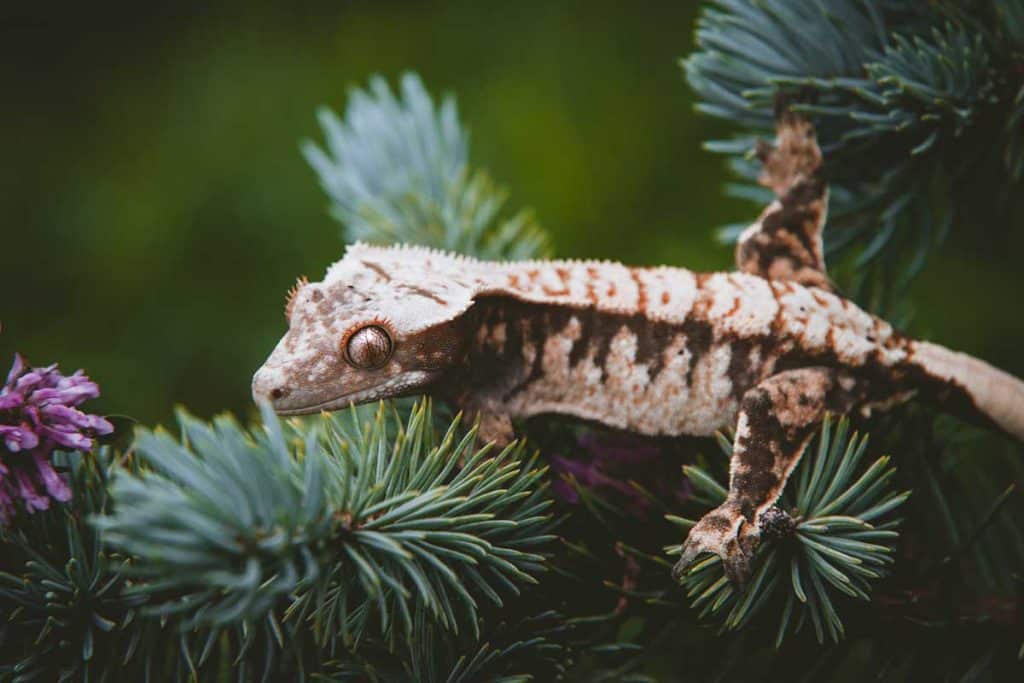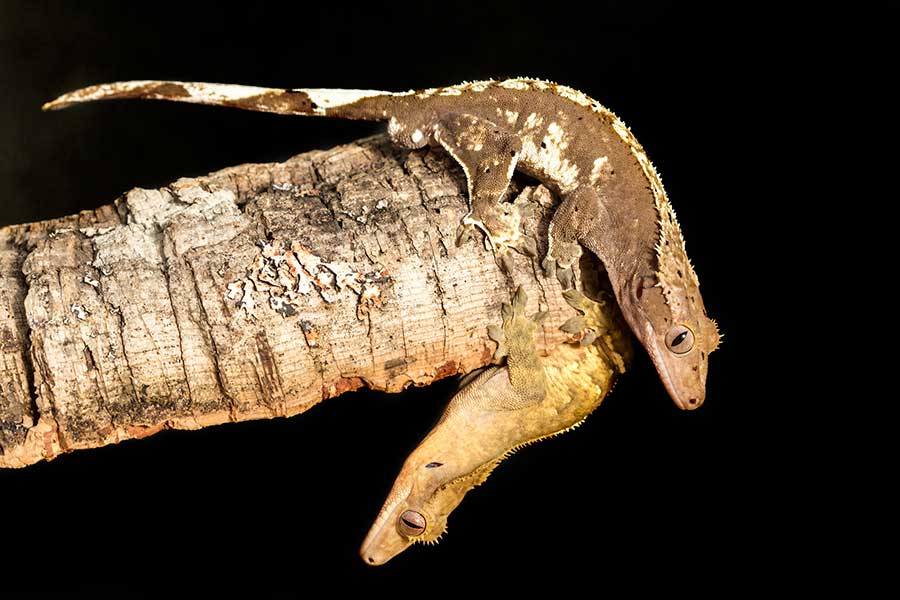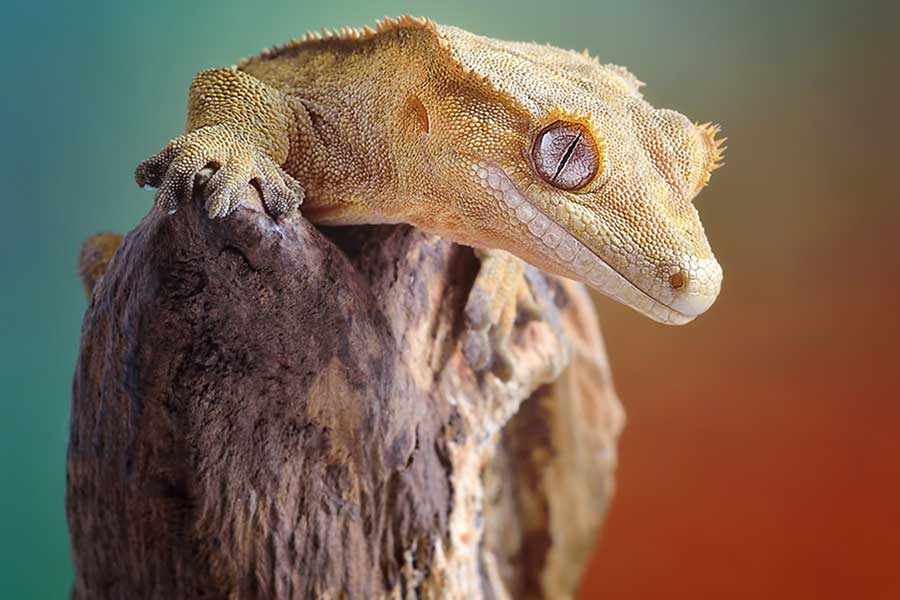How do you sex a crested gecko?
Crested geckos are very small lizards, and so there can be some difficulty when it comes to telling them apart. However, once you know exactly what traits to look for, sexing crested geckos is fairly easy.
There are a number of different factors that can help you tell if a crested gecko is a male or a female. However, relying on only one of these factors to determine sex is often unreliable. To accurately sex your crested gecko, you’ll need to be able to examine a combination of different traits once the gecko has reached a certain age.
Read on to learn more about how to safely and easily tell your cresties apart!
Main Differences Between Male vs Female Crested Geckos
The main differences between male vs female crested geckos are:
- Male crested geckos have broader heads, whereas female crested geckos’ heads are slimmer
- Male crested geckos have larger cloacal spurs, whereas females will generally have smaller cloacal spurs
- Male crested geckos have an enlarged hemipenal bulge at the base of their tails, whereas females have a small or completely absent bulge.
- Male crested geckos have distinct preanal pores on their lower bellies, whereas females have small or no preanal pores.
- Male crested geckos do not lay eggs, whereas female crested geckos will lay eggs even if no male is present.
- Male crested geckos are at a lower risk for MBD, whereas female crested geckos are more prone to
calcium deficiency and egg binding.
Male and female crested geckos look pretty much the same at a glance, and both sexes have similar care requirements. This means many gecko owners mistakenly believe the sex of their gecko isn’t important unless they intend to breed them.
However, while male and female crested gecko care is similar, there are some distinct differences you will need to pay close attention to ensure your crestie’s health.
For example, female crested geckos need more
You will only be able to tell the sex of your crested gecko definitively once they become sexually mature. This is around the 12- to 14-month mark for both males and females.
Some distinguishing factors will appear as early as 4 months, but without the rest of the features to compare them to, sexing cresties younger than 12 months can be unreliable. Your 4-month-old Bella may turn out to be a 12-month-old Butch.
Read on to find out exactly what features to look out for to accurately and easily determine your gecko’s sex.
Male Crested Gecko vs Female Crested Gecko: Introduction
In optimal conditions, captive crested geckos typically live for approximately 10 to 15 years. It is important for you to know if your gecko is male or female so you can cater to their specific needs.
Overall Size
There is a small difference in size between male and female crested geckos. They are not truly sexually dimorphic, so you will need to look closely to spot the difference.
Your gecko’s size is generally the least reliable indicator of their sex, but it is still worth looking to when considering all of the differences between the two sexes.
Head Shape
Male crested geckos have slightly broader heads than females. The male’s head will expand more at the neck to accommodate slightly more powerful jaws.
The female crested gecko’s head, on the other hand, is typically slimmer and does not jut out from their body as much as the males’.
Body Size
Male crested geckos are slightly longer than females on average. In addition, they are typically around 20 grams heavier than females on average.
Females and males usually grow at around the same rate, though females can sometimes grow slightly faster than males. However, when the males get to around 18 to 24 months of age, they will put on weight and become larger and heavier than most females of the same age.
Below is a guide you can follow to get an idea of the typical crested gecko’s growth rate and size at each stage of life. Keep in mind the measurements indicated here are from snout tip to tail tip.
Females will stop growing at the 12- to 18-month mark and will max out at around 35 grams. Males, on the other hand, will continue to grow heavier beyond this point and will generally max out at 55 grams.
However, smaller than average males and larger than average females are fairly common, so only referring to your gecko’s size is not the most reliable method of determining their sex.
Genitals
While crested geckos are not sexually dimorphic, there are some small yet distinctly visible differences in their genitalia that are obvious on the outside of their bodies. Remember, these traits won’t become obvious until your gecko is at least 8 to 12 months old.
The Hemipenal Bulge
At the base of your gecko’s tail, there will be a slight swelling or a bulge. Females have a smaller bulge than males do. Some females lack bulges entirely.
The male crested gecko’s bulge will be very large and distinct, just under the base of their tail. Also, if you look carefully at the base of the bulge closest to the tail, you will see a small dip similar to the one present on mammal testicles.
This bulge contains the hemipenes of the male crested gecko. Crested geckos have hemipenes (two penises) because they are lizards and have tails! This means no matter which side of the tail the male ends up on the female, there is no barrier to mating.
Some larger females will also have slight bulges, so it is not reliable to only depend on the hemipenal bulge. Always look for other signs to accurately determine your gecko’s sex.
Preanal and Femoral Pores
Femoral and preanal pores are common distinguishing factors when it comes to determining the sex of most species of lizards. The pores on male lizards excrete pheromones that the lizards rub onto surfaces to attract mates. The pores typically run in a straight line above the vent between the hind legs.
For example, telling the difference between a male and female leopard gecko by the femoral pores is fairly simple because their pores are large and obvious.
However, identifying the preanal pores on a crested gecko can be slightly more difficult because they are not obviously visible unless you have a magnifying glass. A simple and cheap jeweler’s loupe and good lighting is usually sufficient for you to see the small line of concave preanal pores.
Some females will also have enlarged preanal pores, so be sure to refer to all of the traits mentioned here to determine your gecko’s sex as accurately as possible.
Cloacal Spurs
Cloacal spurs are pretty obvious to identify on a crested gecko. They are on either side of the base of the tail next to the cloaca. They are small, tough triangles jutting outward from the base of the tail. Unlike other reptiles like snakes, females also have cloacal spurs!
It is important to note, though, that male crested geckos tend to have much larger cloacal spurs than females. Many breeders also believe that males develop their cloacal spurs at around 4 to 5 months old, whereas females develop them later on in life.
Behavior
Male and female crested geckos have similar behaviors in terms of everyday life. Many gecko owners have noted that females are more active than males, but males tend to be more vocal and noisy than females.
Other than this, there is one main behavioral difference you can look for that will determine your gecko’s sex with 100% certainty.
Eggs and Egg Laying
As you might have guessed, egg laying and its associated behaviors are the biggest behavioral differences between male and female crested geckos.
Male will obviously not lay eggs. Females will lay eggs, even when they have not come into contact with males! They will occasionally lay unfertilized eggs similar to how female chickens do.
This is also part of the reason why knowing if your crested gecko is a male or female is important. Females will need to have a nesting box in their enclosure to make them feel comfortable and secure when it’s time for them to lay eggs. They may become slightly aggressive around their nesting box, so make sure it is somewhere they feel secure and it is away from the enclosure door.
Additionally, the nesting box will need some safe loose substrate in it so the gecko can safely bury her eggs. Without an inch or two of substrate, your gecko may become stressed if her eggs are exposed.
Sex-Specific Health Problems
Due to their similar natures, there are not many health issues that apply strictly to males or females. However, because females lay eggs, there are two things you need to watch out for.
Metabolic Bone Disease
Egg development and laying take a lot of energy from the female crestie. They need to have additional
If the extra
Metabolic bone disease is the bending and breaking of bones and joints in a reptile’s body due to a lack of
If you have determined your crested gecko is a female, be sure to offer her plenty of food dusted with
calcium powder whenever she lays eggs.
Egg Binding
A female crested gecko can become egg-bound when an egg gets trapped in her reproductive system and she is unable to pass it. This is scientifically known as dystocia.
Egg binding usually happens because there is something wrong with the reptile’s husbandry. If this happens to your crestie, double-check all of their enclosure features. Check that their heat and/or UVB bulb has not run out, check the thermostat is working properly, and make sure they are getting enough food and water. Be sure the humidity and temperature levels are within an acceptable range.
Dystocia is painful and can be fatal. If you are not a trained professional, then you will need to get your crestie to the vet as soon as possible to avoid any serious damage being done if she becomes egg bound.
How to Handle Your Crested Gecko When Sexing Them
As you would probably imagine, determining your gecko’s sex can be annoying and even stressful for them. Most animals don’t appreciate their genitals being poked and stared at, so keep these tips in mind when handling your gecko.
Pick Them Up Carefully
One method of examining your crested gecko to determine sex is to pick them up. Gently lift them up and hold them securely but loosely in your hand. Hold the gecko just above your head, and be sure there is a cushioned surface underneath them if they fall or you happen to drop them.
Next, carefully examine their bellies for the hemipenal bulges, cloacal spurs, and preanal pores. You can use a magnifying glass, a jeweler’s loupe, and/or a small flashlight to get a closer look.
However, most crested gecko owners know that cresties can quickly drop their tails at even the smallest stressor. If your gecko is especially skittish and isn’t socialized well enough to tolerate handling yet, refer to the next tip below.
Put Them in a Transparent Container
If you are worried about a dropped tail or your crested gecko will not keep still, then just put them in a small container with a see-through bottom! That way, you can hold them securely and use your jeweler’s loupe or magnifying glass to examine their belly and tail area!
Male Crested Gecko vs Female Crested Gecko: Which Should You Get?
At the end of the day, it really comes down to personal preference. Females do need slightly more care to avoid metabolic bone disease and egg binding from happening. Females also need a nesting box in their enclosure to make them feel safe when it’s time for them to lay eggs.
Other than that, though, males and females are the same as far as care requirements.
Furthermore, there is very little difference size-wise between the two, so you won’t need a larger enclosure to accommodate a male crested gecko. However, you will need to decide how many crested geckos you want to keep together, as the answer will influence whether a male or female gecko is better for you.
This is because male geckos cannot be housed together under any circumstances. Because they are territorial and aggressive, male crested geckos will fight if you cohabitate them. Females, on the other hand, are more docile and social towards one another and can be housed together with little to no issues as long as the enclosure is spacious enough.
FAQs on Sexing Crested Geckos
Can I tell what sex my crested gecko will be if I get them as an egg?
Crested geckos’ sexes are temperature-dependent. This means a crested gecko’s sex actually depends on the temperature at which their egg is incubated!
While most pet shops usually don’t know the sexes of their geckos, if you adopt your gecko from a reputable breeder, they will almost definitely know if your new scaly friend is male or female.
Can I tell the sex of my crested gecko only by the size of their spurs?
Just like the males, crested gecko females can also sometimes have large, pronounced spurs next to their vent/cloaca. Using these alone to tell what sex your crested gecko is would be unreliable.
Do male or female crested geckos drop their tails more?
Neither sex is more prone to dropping their tails. Tail dropping is due to stress, not your gecko’s sex.
Can I keep two female crested geckos in the same enclosure?
Two or more female crested geckos can live together harmoniously as long as you have increased the size of the enclosure by at least 10 gallons per gecko and provided extra hides, water dishes, nesting boxes, and food dishes.
Can I keep two male crested geckos in the same enclosure?
Male crested geckos can get very territorial and aggressive towards one another. It is inadvisable to keep two males in the same enclosure, as they may attack each other or suffer severely from stress.
Can I keep a male and a female crested gecko in the same enclosure?
You can keep a male and female of the same size together. You will, however, still need to increase the enclosure size by at least 10 gallons for the additional gecko and provide extra hides, and food and water dishes.
Of course, you’ll need to be prepared for the inevitable: fertilized eggs (and possibly baby geckos)!
Springing Off…
Crested geckos are one of the best pet geckos to own if you are looking for a small, slightly vocal lizard that loves to jump.
Learning how to tell a male crested gecko from a female crested gecko can be tricky. However, once you have identified all of the factors that signify sex, you can compile your findings and come to a definitive and scientific result!
Remember, depending on your gecko’s sex, they will have slightly different care requirements, such as females needing extra
Either way, whether you intend to adopt a male or female will depend mostly on your personal preferences.




